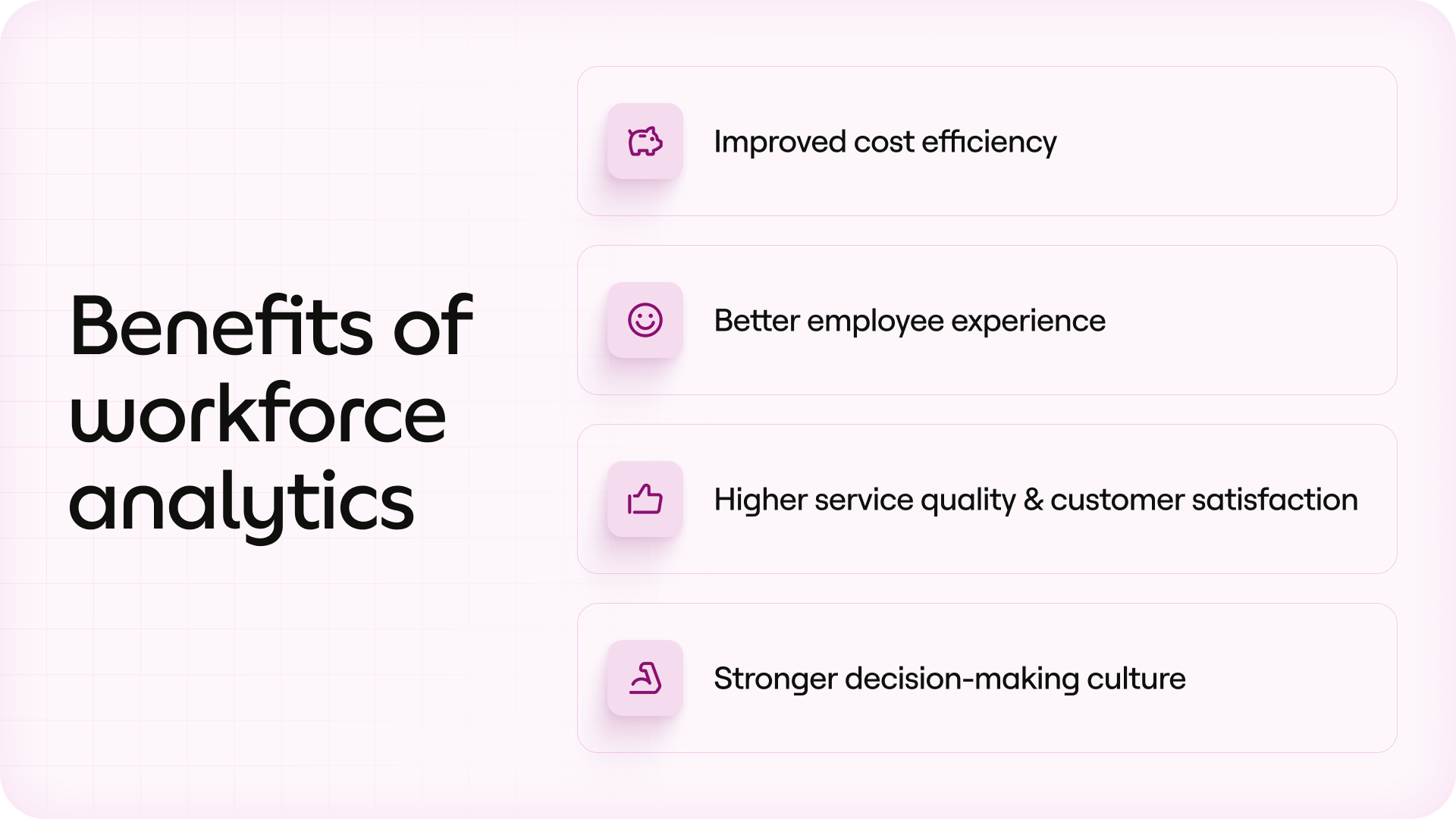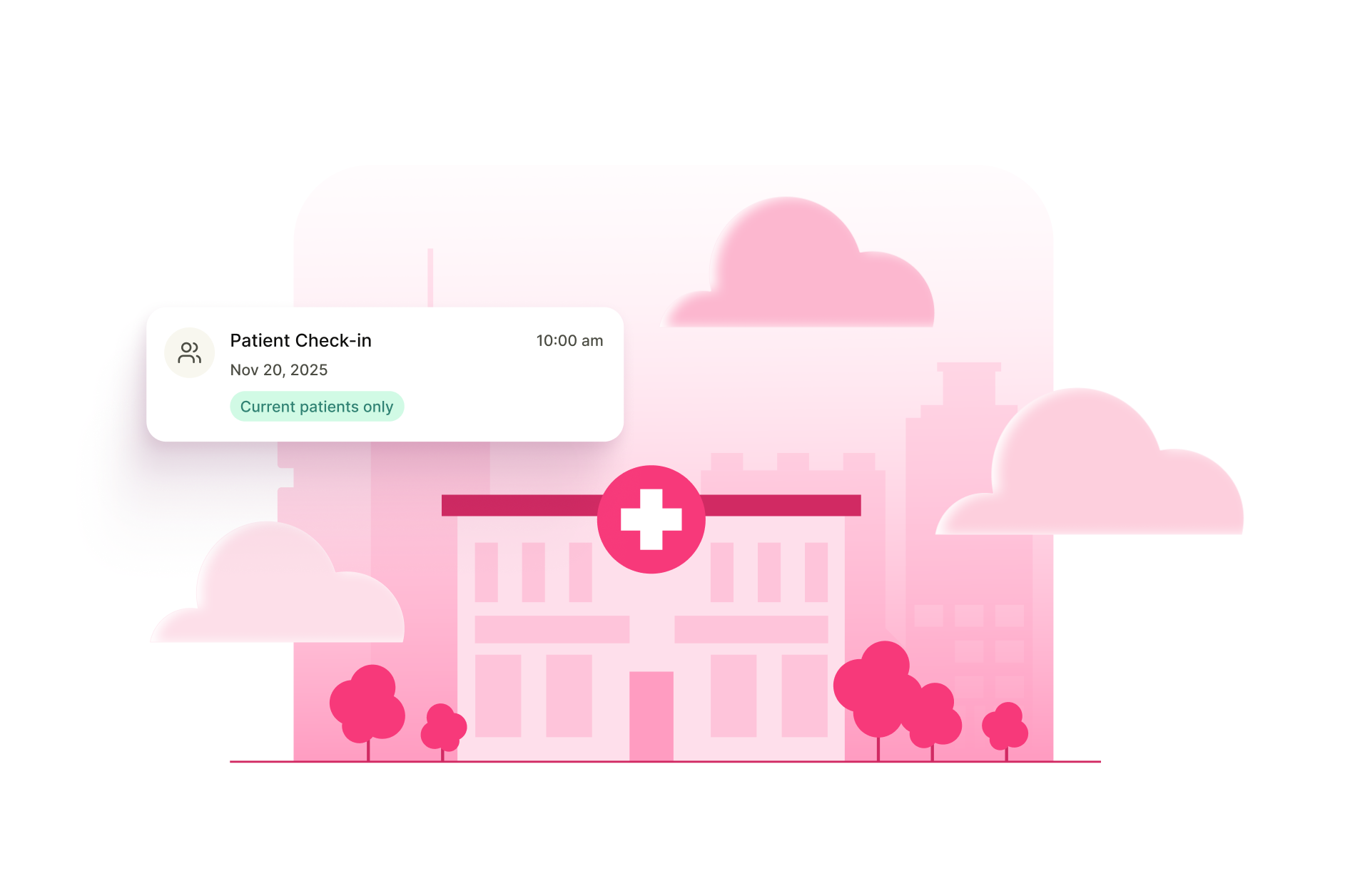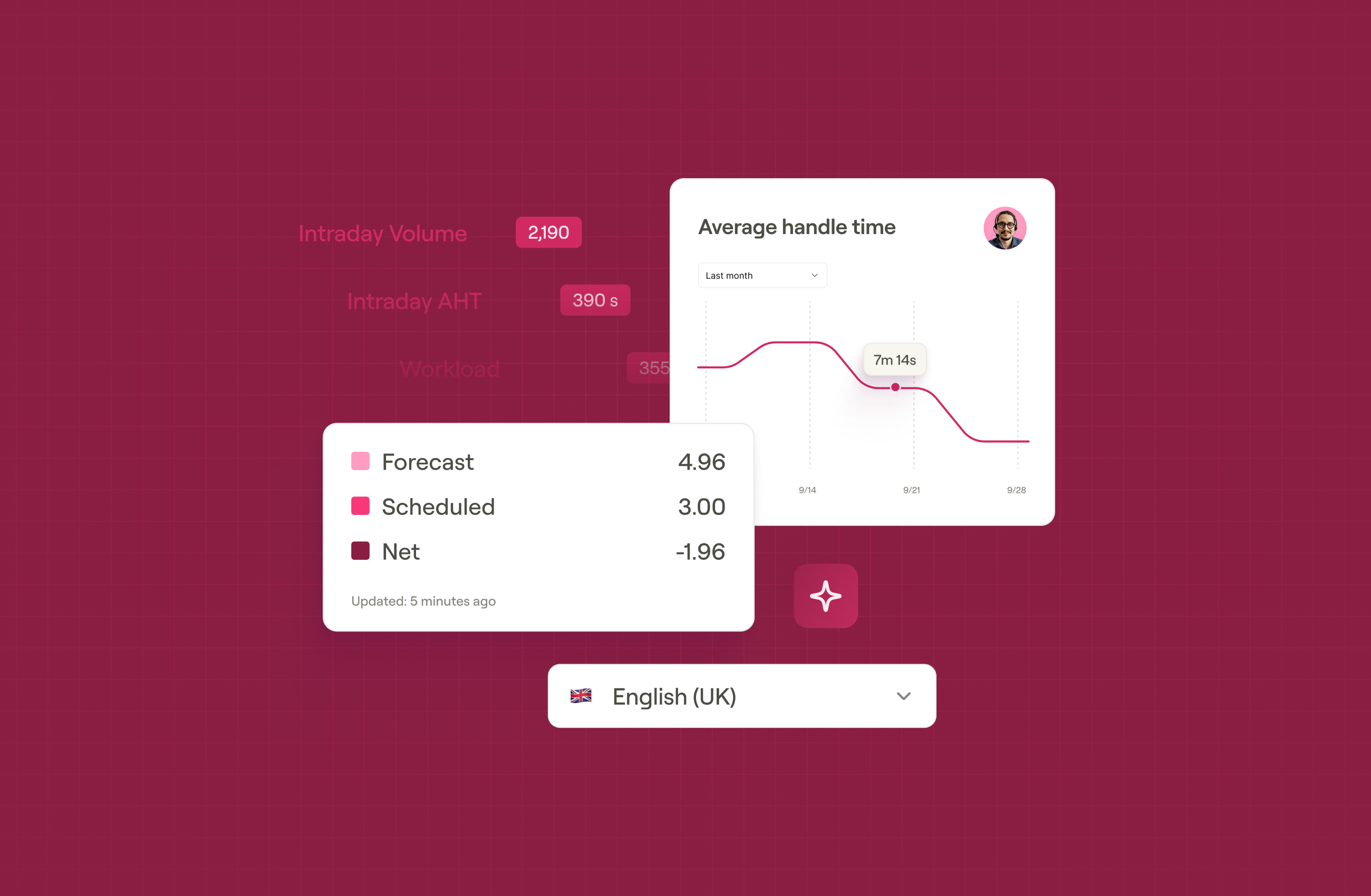Workforce data analytics transform how enterprise contact centers make decisions about staffing, forecasting, and employee performance by replacing guesswork with evidence-based strategies.
For large operations struggling with daily fire drills, rising operational costs, and agent burnout, data-driven workforce management delivers measurable cost reductions, higher service levels, and improved agent retention that directly impact the bottom line.
What is workforce analytics?
Workforce analytics is the process of collecting and analyzing customer, employee and operational data. These insights help workforce leaders make smarter decisions about scheduling, forecasting, and employee engagement.
In enterprise contact centers, workforce analytics might reveal exactly how many agents you need for Thursday's afternoon shift, pinpoint why certain teams consistently miss adherence targets, or predict which agents are at risk of leaving. The goal is to connect data points like schedule adherence, forecast accuracy, and customer outcomes so leaders can make informed decisions.
Unlike traditional reporting, which tells you what already happened, like last month's adherence or yesterday's call volume, workforce analytics is proactive and actionable. It flags when demand is likely to spike, identifies agents who are at risk of burnout, and suggests schedule changes that will cut overtime costs while creating fairer shifts for your team.
Types of workforce analytics
Descriptive analytics
Descriptive analytics focuses on historical data. It helps leaders see what normal operations look like before implementing changes, like attendance trends, schedule adherence, peak call times, or agent turnover rates.
This type of analysis answers questions like:
- How many agents were absent last month?
- How many calls were handled last month?
- What shifts had the highest overtime costs?
- Which teams showed the best schedule adherence?
- Where did turnover spike during the past year?
While descriptive analytics doesn't predict the future, it provides the context leaders need to understand performance baselines.
Predictive analytics
Predictive analytics uses data from statistical models to forecast workforce demand and staffing needs. Instead of only showing past trends, it forecasts what is likely to happen based on historical patterns and external factors.
By analyzing patterns in customer interactions, predictive models can estimate how many agents will be needed next Tuesday at 2 p.m., or how call volume might spike during a product launch. These forecasts help leaders schedule the right number of people at the correct times, reducing overstaffing and understaffing.
AI and machine learning have made predictive analytics more accurate. These technologies can analyze years of historical contact center data, account for seasonal trends, and adjust forecasts based on real-time conditions.
Prescriptive analytics
Prescriptive analytics goes beyond prediction by providing specific recommendations to improve scheduling, workload distribution, and employee engagement. It answers questions like:
- Which agents should we assign to this campaign?
- How should we adjust schedules to meet service level targets?
- What changes will reduce overtime cost?
- How can we apply skill-based scheduling to match the right agents with the right tasks?
For example, prescriptive analytics might recommend reassigning high-performing agents to a complex customer queue or suggest adjusting break times to align with call volume patterns. This helps leaders make decisions quickly, without spending hours analyzing spreadsheets and other data sources.
Key workforce analytics metrics to track
While every contact center has unique goals, the following metrics consistently deliver the most value for workforce planning and agent management:
- Schedule adherence. Measures how closely agents follow their assigned schedules. Low adherence rates can indicate problems with workload balance, training gaps, or employee disengagement. Improving schedule adherence starts with understanding why agents deviate from their schedules in the first place.
- Forecast accuracy. Tracks how closely actual call volume matches predicted volume. When forecasts miss the mark, the result is either overstaffing, which increases operational costs, or understaffing, which drives up wait times and overloads the team. Accurate forecasts are key to balancing cost and customer experience.
- Agent productivity. Measures how effectively agents use their time during shifts, including calls handled per hour, resolution rates, after-call work completion, and other measurable activities. This data helps leaders identify top performers, struggling agents who need additional support, and systemic workflow problems that affect entire teams.
- Employee turnover. Measures how many agents leave within specific time periods and analyzes the patterns behind departures. High turnover usually indicates serious operational problems: agent burnout from poor scheduling, inadequate management support, limited career development, or compensation issues.
- Customer satisfaction. Scores such as customer satisfaction (CSAT) or first call resolution show how well agents meet customer needs. These customer-facing metrics are directly tied to workforce performance and affect business goals. Low satisfaction often links back to issues like staffing shortages, insufficient training, or high agent stress.
- Cost-to-serve. Calculates the labor cost required to handle each customer interaction. This metric helps leaders assess whether changes in scheduling, forecasting, or training are improving efficiency.
Analyzing these metrics individually provides limited insight. High customer satisfaction scores might seem positive, but if they come with unsustainable turnover rates or excessive overtime costs, the operation is heading toward failure. Workforce leaders need to consider these metrics together to understand the full picture and make balanced decisions.
Workforce analytics in practice
Real-world applications of workforce analytics address the challenges that create operational and financial pressure in enterprise contact centers.
Optimizing staffing to reduce overtime
Many contact centers operate reactively, struggling to cover unexpected absences, call spikes, and scheduling conflicts that lead to expensive overtime or service failures.
Workforce analytics changes this pattern by analyzing adherence trends, seasonal demand patterns, and historical data to predict where staffing issues will occur before they happen.
Improving forecasting accuracy to cut costs
Inaccurate forecasting creates a cascade of expensive problems throughout contact center operations.
When forecasts underestimate demand, service levels suffer and remaining agents face excessive workloads, increasing the risk of burnout and dissatisfaction. When forecasts overestimate demand, labor costs increase unnecessarily and agents may face reduced hours or scheduling conflicts.
With better forecasts, contact centers can align schedules more closely to actual demand, preventing overstaffing during slow periods and understaffing during peak times.
Identifying performance trends to boost engagement
Workforce analytics can identify early warning signs of agent disengagement before performance deteriorates and valuable employees leave. Declining productivity, increasing adherence problems, higher absence rates, and lower customer satisfaction scores often cluster together weeks before agents quit.
Early detection allows leaders to intervene with targeted coaching, schedule adjustments, workload modifications, engagement tactics, or career development opportunities. Preventing turnover costs far less than constantly recruiting, hiring, and training replacement agents while maintaining service levels during staffing transitions.
To learn more, explore our guide: ‘Why employee engagement is the key to performance management success.’
Balancing service quality with cost control
Every staffing decision requires balancing between service levels, agent experience, and operational costs. Workforce analytics provides the data needed to make informed choices, rather than guessing at the impact.
Intraday management and real-time adjustments
Even the most accurate forecasts can’t predict every surprise. Equipment failures, weather events, viral social media posts, or breaking news can dramatically alter call patterns within minutes. AI-powered analytics systems monitor actual conditions throughout each shift, detecting problems as they develop and recommending immediate responses.
This might involve reassigning agents between different queues, calling in backup staff, adjusting break schedules, or modifying service procedures to maintain targets without creating operational chaos.
Benefits of workforce analytics

When properly adopted, workforce analytics can deliver measurable benefits across different aspects of contact center operations:
- Improved cost efficiency. More accurate forecasting reduces both overstaffing and overtime, while smarter scheduling ensures labor resources are used effectively. For large contact centers managing thousands of agents, even small efficiency gains can deliver significant cost savings.
- Better employee experience. With data highlighting where employees are struggling, leaders can act before burnout or disengagement occurs. More balanced workloads, dynamic scheduling, and tailored coaching lead to higher retention, stronger morale, and better performance overall.
- Higher service quality and customer satisfaction. When the right number of skilled agents is available, customers get faster, more effective service. Workforce analytics helps leaders maintain service levels without overwhelming employees, improving both customer outcomes and agent engagement.
- Stronger decision-making culture. Access to real-time data and predictive insights enables leaders to make more informed decisions. Instead of relying on intuition or outdated information, they can make data-driven choices about staffing, scheduling, and resource allocation, reducing risk and improving results across the board.
Challenges in adopting workforce analytics
Despite clear benefits, many enterprise contact centers struggle to implement effective workforce analytics programs due to organizational and technical challenges.
Data silos
When workforce data lives in separate systems, it becomes difficult to get a complete view of workforce performance.
Successful workforce analytics integrates these disconnected systems into a unified platform that provides accurate, timely, and complete information for decision-making. A unified WFM platform helps fill gaps, update missing records, and reduce the risk of errors or misleading conclusions.
Lack of skilled analysts
Effective workforce analytics requires people who understand both strategic analysis and contact center operations. Many organizations lack staff with this combination of skills, leading to either technically sophisticated reports that miss operational context or operationally relevant analysis that lacks strategic insights.
Building analytical capabilities requires either training existing staff or hiring people who can bridge this knowledge gap.
Resistance to change
Some teams resist shifting from intuition-based decisions to data-driven processes, particularly if they have been successful with traditional methods. They may worry that metrics will oversimplify complex situations, reduce their decision-making authority, or expose performance problems that were previously hidden.
Overcoming this resistance requires demonstrating how analytics enhance rather than replace human judgment, and showing concrete examples of improved outcomes that benefit both leaders and their teams.
Best practices for implementing workforce analytics
Successful workforce analytics implementation follows proven strategies that build momentum while delivering tangible results.
- Define clear business objectives. Begin by identifying the specific problems you want to solve. Are you focused on reducing costs, improving service levels, or boosting employee engagement? Clear objectives make it easier to choose the right metrics, measure progress, and demonstrate value to stakeholders who control budgets and resources.
- Focus on actionable metrics. Start with metrics that have the most significant impact. Most enterprise contact centers benefit immediately from improved forecast accuracy, better schedule adherence monitoring, and early identification of agent performance issues. As your analytics program matures, you can expand into additional metrics and explore more advanced insights.
- Ensure data integration. Analytics deliver the most value when data is unified. Pull information from HR, workforce management, quality management, performance management, and CRM systems into one view. Look for tools with pre-built integrations or APIs to streamline data exchange and reduce manual work.
- Include leadership buy-in and oversight. Senior contact center leaders are more likely to support analytics when they see clear benefits, such as reduced overtime costs or improved service levels. Launch with a pilot project that delivers measurable results, then scale.
- Link insights to action. Analytics only matter if they change how work gets done. Build processes that translate data into action. Examples include automating schedule adjustments based on forecast changes, flagging agents for coaching, or identifying employees ready for new opportunities.
Workforce analytics impact across industries

Workforce analytics creates value across multiple industries, but each sector faces distinct operational challenges that require tailored approaches.
Healthcare systems
Workforce analytics helps healthcare organizations predict demand spikes during flu season or after major health news events, allowing them to adjust staffing proactively rather than scrambling for overtime coverage.
Analytics also ensure compliance with union agreements and labor regulations while optimizing shift patterns to reduce staff burnout. The result is better patient service, controlled costs, and higher employee satisfaction in an industry where retention directly affects care quality.
Financial services and banking
Analytics platforms help financial contact centers maintain appropriate staffing levels during market turbulence while avoiding excessive labor costs during regular periods. Predictive models factor in economic indicators, marketing campaigns, and historical patterns to forecast demand accurately.
Retail operations
Retail contact centers experience extreme seasonal variations, promotional campaigns, product launches, and shipping deadline pressures that create staffing challenges across multiple customer service channels.
Workforce analytics allows retailers to prepare for these predictable demand spikes while maintaining efficient operations during slower periods. Advanced forecasting models account for promotional calendars, inventory levels, shipping delays, and social media trends that influence customer service needs.
Utilities and energy companies
Analytics platforms help utilities predict call volumes based on weather forecasts, maintenance schedules, and historical patterns, enabling them to maintain adequate emergency response capability while optimizing routine operations. This ensures customers receive timely assistance during outages and emergencies while controlling labor costs during normal operating conditions.
What to look for in a workforce analytics platform
Choosing the right workforce analytics platform requires focusing on capabilities that transform raw data into decisions that improve daily operations.
- Real-time visibility & dashboards. Leaders need access to current performance, not just past reports. They need to spot developing problems, like sudden call spikes, unexpected absences, and adherence issues, early enough to take corrective action before service levels suffer or overtime costs escalate.
- Advanced forecasting & AI modeling. Forecast accuracy separates effective workforce analytics platforms from basic reporting tools. The strongest platforms use AI and machine learning to analyze historical data, identify trends, and forecast future demand with high precision. These models should also adjust for seasonality, market shifts, or other external factors that influence call volume.
- Smooth integration across various platforms. Analytics delivers the most value when it connects with other tools. Look for solutions that integrate with workforce management (WFM), HR platforms, CRM systems, and performance management tools. This reduces manual work, keeps data consistent, and makes sure schedules can be adjusted automatically.
- Intraday management capabilities. The platform should detect when actual conditions deviate from the forecast and recommend actions mid-shift. This might include adjusting break times, reassigning agents to different queues, or calling in backup staff to maintain service levels.
- Support for employee engagement. The right system goes beyond monitoring performance. Features like adherence tracking, productivity insights, and gamification help agents stay motivated and aligned with team goals. When employees see how their work connects to broader success, engagement and performance improve.
Why choose Aspect for workforce analytics
Workforce data analytics is only valuable if it drives action. Aspect’s workforce engagement and workforce management platforms are built for large, complex contact centers that need more than surface-level reporting. Our platform combines real-time visibility with advanced forecasting, intraday optimization, and actionable insights to help leaders make better decisions every day.
Here’s an overview of Aspect's offerings:
- Advanced forecasting powered by AI and machine learning: AI and machine learning models analyze historical data to predict staffing needs with accuracy. Leaders can plan ahead and reduce both understaffing crises and expensive overstaffing situations.
- Productivity tracking: Leaders gain clear visibility into how agents spend their time across teams and channels. This allows them to recognize high performers, identify training and engagement opportunities, and balance workloads more effectively.
- Adherence monitoring: Schedule adherence is tracked in real time, so leaders can see where adjustments are needed to maintain service levels without overloading agents.
- Intraday optimization: When actual conditions deviate from forecasts, the platform recommends adjustments like shifting break times, reassigning agents, or activating backup staff. This keeps operations efficient while protecting service quality.
- Performance analytics: Leaders can track key metrics like handle time, first call resolution, and quality scores across agents and teams. These insights highlight performance gaps, guide coaching efforts, and help align workforce behavior with organizational goals.
- Support for complexity: From union compliance requirements to multi-channel operations and distributed workforces, Aspect is designed to handle the challenges of enterprise contact centers.
- Gamification and engagement: Analytics doesn’t stop at insight. With built-in engagement tools like gamification, recognition programs, and customized challenges, leaders can reduce agent turnover and boost productivity by making daily work more engaging and rewarding.
Workforce leaders using Aspect's purpose-built WFM platform gain the tools to develop resilient operations that adjust to everyday challenges and improve performance across teams and customer experiences. For organizations that want to turn workforce analytics into workforce action, Aspect is your trusted partner.
Workforce analytics can help enterprise contact centers improve key metrics and make smarter, faster decisions.
Aspect’s unified workforce management platform integrates these capabilities. With AI-powered forecasting, real-time visibility, and built-in engagement tools, Aspect is designed to turn workforce data into measurable results.
- How can workforce analytics improve call center performance?
Workforce analytics helps call centers match staffing levels with customer demand more accurately. It also highlights gaps in agent performance, training needs, and scheduling inefficiencies, giving leaders the insights they need to reduce wait times, improve service quality, and control labor costs.
- Which industries benefit most from workforce analytics?
While workforce analytics is valuable for any business, it is especially impactful in industries with high-volume customer interactions. Contact centers, financial services, healthcare, retail, and utilities often rely on it to manage complex scheduling requirements, compliance rules, and customer service expectations.
- What are the most important metrics in workforce analytics?
Key metrics depend on business goals, but common ones include schedule adherence, forecast accuracy, agent productivity, and employee turnover. In contact centers, additional measures like average handle time, first call resolution, and customer satisfaction scores are often tracked to understand workforce performance and customer impact.









